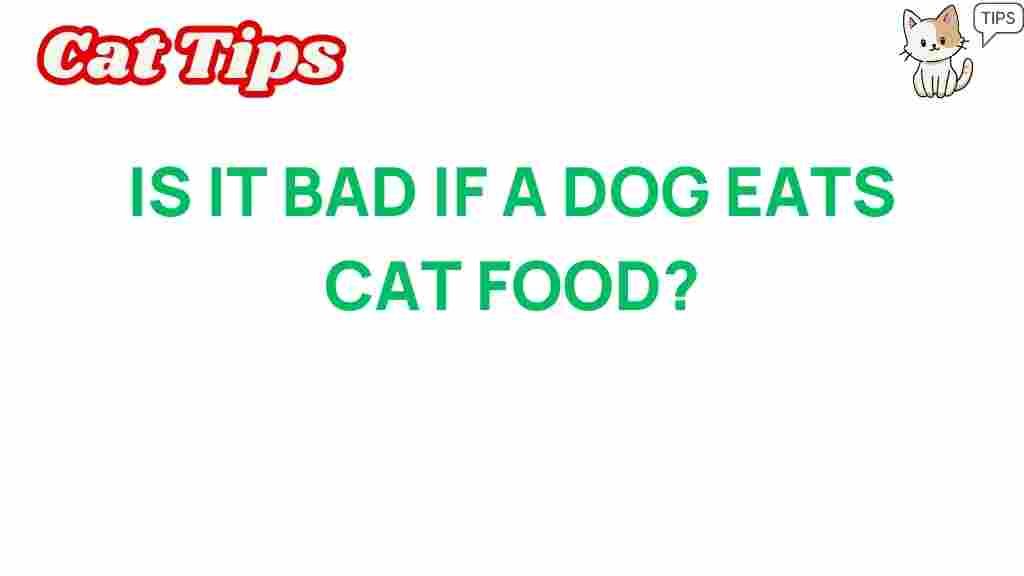The Surprising Truth: Is It Bad If a Dog Eats Cat Food? – Understanding Dog Health
As pet owners, we often find ourselves questioning the dietary habits of our furry friends. One common concern is whether it’s harmful for a dog to eat cat food. While it may seem harmless to allow your dog to munch on some leftover cat food, understanding the implications for dog health is crucial. In this article, we’ll explore the differences between dog and cat food, the potential health risks involved, and what you should do if your dog has eaten cat food.
Understanding the Nutritional Needs of Dogs and Cats
To grasp the core of the issue, we must first look at the nutritional requirements of both species. Dogs and cats have different dietary needs due to their distinct evolutionary backgrounds.
- Dogs: Dogs are omnivores, meaning they can thrive on a mixed diet of meat, grains, and vegetables. Their nutritional needs include proteins, fats, carbohydrates, vitamins, and minerals.
- Cats: Cats are obligate carnivores, which means their diet must be high in protein and fat. They require specific nutrients such as taurine, which is not as critical for dogs.
Because of these differences, cat food is formulated to meet the higher protein and fat requirements of cats. This disparity can lead to potential issues for dogs that consume cat food regularly.
Potential Risks of Dogs Eating Cat Food
While an occasional bite of cat food might not harm your dog, frequent consumption can pose several risks to dog health:
- Nutritional Imbalance: Cat food is richer in protein and fat than dog food, which can lead to weight gain and obesity in dogs if consumed regularly.
- Pancreatitis: The high fat content in cat food can trigger pancreatitis in dogs, a serious condition that requires immediate veterinary attention.
- Gastrointestinal Upset: Dogs that eat cat food may experience vomiting, diarrhea, or stomach cramps due to the sudden change in diet.
- Increased Thirst and Urination: The higher protein levels can lead to increased thirst and urination, potentially causing discomfort and dehydration.
Understanding these risks is vital for maintaining your dog’s health. If you notice any adverse symptoms after your dog eats cat food, consult your veterinarian promptly.
What Should You Do If Your Dog Eats Cat Food?
If your dog has eaten cat food, there are steps you can take to ensure their well-being:
- Monitor Your Dog: Keep an eye on your dog for any signs of distress or unusual behavior. Common symptoms include vomiting, diarrhea, or lethargy.
- Consult Your Veterinarian: If your dog shows any concerning symptoms, contact your vet for advice. They may recommend bringing your dog in for an examination.
- Prevent Future Incidents: To avoid your dog eating cat food again, consider feeding your cat in a separate room or elevated area that your dog cannot access.
How to Transition Your Dog to a Healthier Diet
If you suspect your dog has developed a taste for cat food, it’s essential to transition them back to a proper diet suitable for dogs. Here’s how to do it:
- Choose Quality Dog Food: Select a balanced dog food that meets your dog’s specific age, size, and health needs.
- Gradual Transition: Introduce the new dog food gradually over a week, mixing it with their current food to avoid gastrointestinal upset.
- Monitor Their Reaction: Observe how your dog responds to the new food. Look for signs of allergies or intolerance.
- Adjust Portions: Ensure you’re feeding the correct portion size based on your dog’s weight and activity level to prevent overfeeding.
By following these steps, you can help maintain your dog’s health and avoid the temptation of cat food in the future.
Troubleshooting Tips for Common Issues
Even with the best intentions, there may be times when your dog gets into the cat food stash. Here are some troubleshooting tips:
- Behavioral Training: If your dog is sneaky around the cat’s food, consider behavioral training techniques to discourage this behavior, such as positive reinforcement.
- Feeding Schedule: Keep a consistent feeding schedule for both your dog and cat to reduce the opportunity for cross-feeding.
- Food Storage: Store cat food in a secure container that your dog cannot access.
- Separate Eating Areas: Set up different feeding zones for your cat and dog to minimize the chance of your dog eating cat food.
Implementing these strategies can help ensure your dog stays healthy and doesn’t indulge in cat food again.
When to Seek Professional Help
In some cases, eating cat food may lead to serious health issues. Know when to seek professional help:
- If your dog shows persistent vomiting or diarrhea.
- If your dog becomes lethargic or unresponsive.
- If there are signs of dehydration, such as dry gums or excessive panting.
- For ongoing dietary concerns, consulting with your veterinarian is always a good idea.
Being proactive about your dog’s health can prevent complications from arising due to improper dietary habits.
Conclusion
In conclusion, while it may not be catastrophic for a dog to eat cat food occasionally, consistent consumption can lead to various health issues. Understanding the nutritional differences between dog and cat food is essential for maintaining your dog’s well-being. Always rely on a balanced diet formulated for dogs to keep them healthy and happy.
If you’ve found this information helpful, consider exploring more about pet nutrition and health here. Remember, your dog’s health is paramount, and keeping their diet in check is one of the best ways to show your love.
For further reading on pet diets, you can check out this resource that provides in-depth insights into feeding your furry friends.
This article is in the category Nutrition and created by CatTips Team
